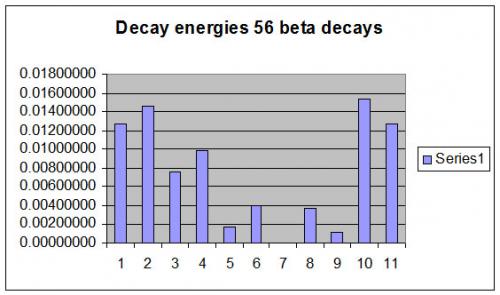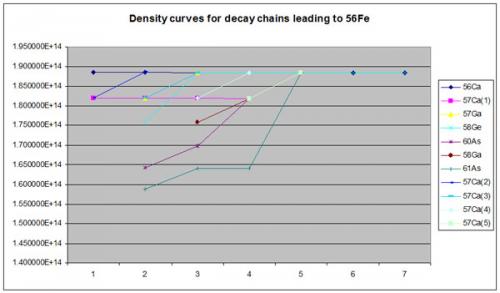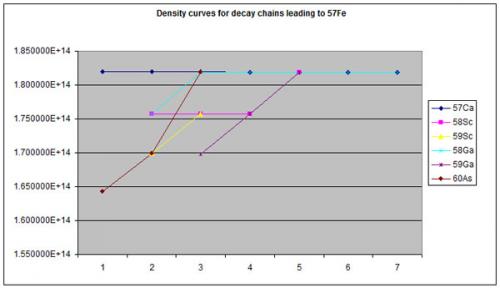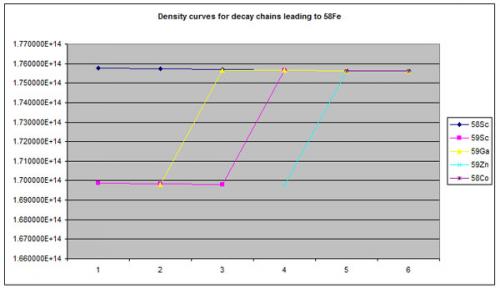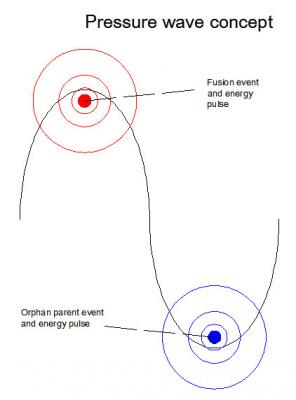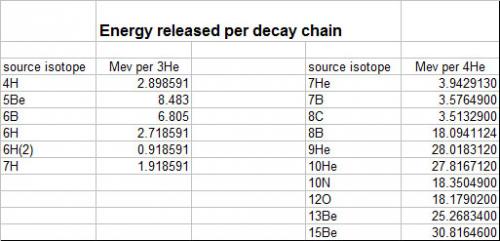

occam
Senior Members-
Posts
44 -
Joined
-
Last visited
Retained
- Quark
occam's Achievements

Quark (2/13)
11
Reputation
-
No look at IsosortB there is no neutron bombardment! the decay mode is beta minus, which adds an extra shell electron at each decay stage.
-
As you can now read IsosortB I presume you have noticed that Uranium is produced from Thorium
-
I suppose it hasn't helped that all the access permissions were set incorrectly! Could someone please check that all the spreadsheets are accessible and downloadable? Thanks
-
This is the same data as you will find in IsosortB, column AE lines 483 to 493 What point are you trying to make?
-
Not quite 238U is the longest lived of the 238 sequence, which commences 238Th for b- chain, and 242Fm (alpha) to 238Cf and then b+ to 238U The further (shorter life) decays happen for all subsequent decays for all sequences above 208 The point of the "source" is there are no precursors, so these must be the primary products of all stellar processes including supernovas
-
Actually there are two possible decay paths from 238U see http://periodictable.com/Isotopes/092.238/index.full.dm.html The most probable (alpha decay) can ultimately lead to 206Pb or 208Pb. the other most unlikely mode is a 2b- decay to 238Pu which yields several of the rare earths 235U has four definite possible paths see http://periodictable.com/Isotopes/092.235/index.full.dm.html the most probable leading to 207Pb with a very low probability to 206Pb 238U is not a "source" isotope for this see http://periodictable.com/Isotopes/092.238/index2.full.dm.html
-
Apologies I set the permissions incorrectly I hope I have now changed it,could someone check please. You will find larger versions of the graphs in the spreadsheet
-
Some observations on abundance: The data for this is in spreadsheet Fe56-58.xls which can be downloaded from https://drive.google.com/file/d/0B3pdkE0Liyu2SFJlYVpWclFueVk/edit?usp=sharing From this the nuclear density curves can be drawn for the decay chains leading to the stable Isotopes. As can be seen the diagram for 56Fe is considerably more complex than those for 57 and 58. This complexity is mainly due to the multiple decay modes of some Isotopes. The data tables therefore also show the relative probabilities of the daughter Isotopes. It is clear from the data that the most probable decay mode also has the highest decay energy. This allows a reasonable estimate of the proportions even where a probability is not given in the source data. From the raw data, 56Fe has seven source isotopes; 57Fe has six source isotopes; and 58Fe has just four. But this simple view can be misleading. In 56 Fe the chain from 61AS has only a 0.023% probability in the decay from 60Ge to 56Ni. Similarly the decay from 57Ti is only 0.3% and from 57V only 0.4%. In the 57 chains only 58Sc has a full yield to 57Fe. The decay of 59Sc gives only 30% leading to 57Fe; similarly 58Ga allows 35% from 57Zn; 60As 35% also from 57Zn; and 59Ga only 3% at 58Zn. The remaining chain 57Ca is shared with 56Fe which takes 30% of the initial decay and another 33% at 57Sc. The net yield to 57Fe is 66% of 70% or only 46.2% For 58Fe the chain from 59Sc is 70% in favour, but at 59V less than 1% continues to become 58Fe. The chain from 59Ga (and 59Zn) effectively terminates at the extremely long lived 2 beta decay 58Ni. Leaving just the chain from 58Sc, and the OP2 58Co.
-
I was expecting to see the “orphan parent” isotopes as products, or by-products of the high energy fusion events. However I cannot find any reference as to how these isotopes are created. The only thing I can think of is that the pressure wave has two stages: the high pressure producing the fusion events, and the low pressure producing the oprphan parents.
-
Yes the 12 year 3H to 3He is the longest of all the steps but not in the lifetime of a star. However it could account for the comparitively much larger abundance of 4He. I add them together to show the total energy produced. The key point is that the fusion process generates the source isotpes as the starting point. the solar energy output is produced by the decay process
-
Some helpful pictures 3He.jpg shows the density curves for the decay chains from source isotopes to 3He 4He.jpg shows the density curves for the decay chains from source isotopes to 4He Helium energy.jpg shows the total energy release by the decay of each isotope to the helium end product The supporting data sheet can be downloaded from https://drive.google.com/file/d/0B3pdkE0Liyu2SmUyZGxmSUp6OUU/edit?usp=sharing Note no quarks anywhere!
-
Quite right, but these are alpha emitters 106Te has the lowest number of nucleons, but the vast majority of alpha emitters have over 200 nucleons. The “source" isotopes are quite different. they are not alpha emitters, instead these condense individually to become 4He atoms The data sheets are now available. They are all Excel spreadsheets: Isodata.xls is the main data capture document https://drive.google.com/file/d/0B3pdkE0Liyu2YTZ2bVFORFVzYTQ/edit?usp=sharing IsosortA.xls is the same data sorted by nuclide number, and then by Proton number. This contains the initial sorting codes and colour highlights https://drive.google.com/file/d/0B3pdkE0Liyu2QXdad3FReFZlaFk/edit?usp=sharing Stabanal.xls is the analysis of the stable isoropes (including the 2beta stable) https://drive.google.com/file/d/0B3pdkE0Liyu2eldSby04clRvTlU/edit?usp=sharing IsosortB.xls expands the sorting codes, and contains the mass calculations https://drive.google.com/file/d/0B3pdkE0Liyu2UGFaZ3VMSEhFcWM/edit?usp=sharing OPanal.xls analyses the “orphan Parents” https://drive.google.com/file/d/0B3pdkE0Liyu2ZzloUlZPdkJITEE/edit?usp=sharing DEanal.xls analyses decay energy patterns https://drive.google.com/file/d/0B3pdkE0Liyu2OWZiUDBqeEhGbGs/edit?usp=sharing headanal.xls looks at the isotoes which ar the “heads” of the nuclide number set https://drive.google.com/file/d/0B3pdkE0Liyu2RDVsY2t2YWFzSEk/edit?usp=sharing ANMandDensity.xls has the main curves for these values https://drive.google.com/file/d/0B3pdkE0Liyu2SGJEMFdjd19wOUk/edit?usp=sharing Hope these help.
-
Still waiting for my hosting site Another finding, buried in the sea of data involves the “Orphan Parents”. If you look at the chain of decays that leads to 3He in http://periodictable.com/Isotopes/002.3/index.full.dm.html you will see that there are only 5 “source” Isotopes that lead to 3He. Similarly for 4He http://periodictable.com/Isotopes/002.4/index.full.dm.html which has 10 source Isotopes 6Li has only 2 http://periodictable.com/Isotopes/003.6/index.full.dm.html and 7Li has 5 http://periodictable.com/Isotopes/003.7/index.full.dm.html and so on; 9Be has 3; 10B has 3; 11B has 4; 12C has 6; 13C has 9 You will notice from Paragraph 22 of Isoanal1.pdf that the density of these nuclei decrease as the number increases. It has been known for some time that there are pressure waves reverberating in the Sun. The consequence is that there must be a “convergence zone” in the depths of the star where these interfere and produce pressure peaks. The implication of the data is that it is not the pressure that causes fusion, but the “trough” which allows the source Isotopes to precipitate. The resultant decay produces another pressure pulse perpetuating the cycle. The deeper the trough, the higher the isotope number.
-
OK I think I have found a suitable site. When I have uploaded the files would you like to check it out before I post the URL in the forum?
-
There is also large energy-mass of neutrino. And kinetic energy of emitted electron/positron. You can see it in Cloud Chamber and compare with other radioactive fission of other element to see difference. As I said in Paragraph 32 of Isoanal1.pdf, the data is not refined enough to identify the neutrino. As for the kinetic energy, this should show as a discrepancy between the mass equivalent of the emitted frequency and the total decay energy. However I was unable to find any comprehensive list of emission frequencies to establish this. You mixed beta decay+ with electron capture.. http://en.wikipedia....lectron_capture Beta decay+ is positron emission http://en.wikipedia....sitron_emission When electron is absorbed by nucleus (in electron capture), one of protons change to neutron. So atomic number Z is decreased, and mass number A remain the same. There is no need to import yet another electron, as far as I am aware. No I did not mix them up. The data sheets clearly identify electron absorbtion from beta+ decays. For the beya plus an extra electron mass is required to balance the equation Moderators: Is there any way that the data files can be put on a trusted file sharing site?

